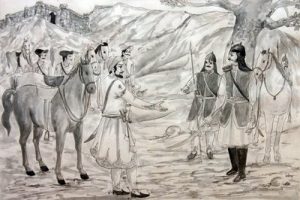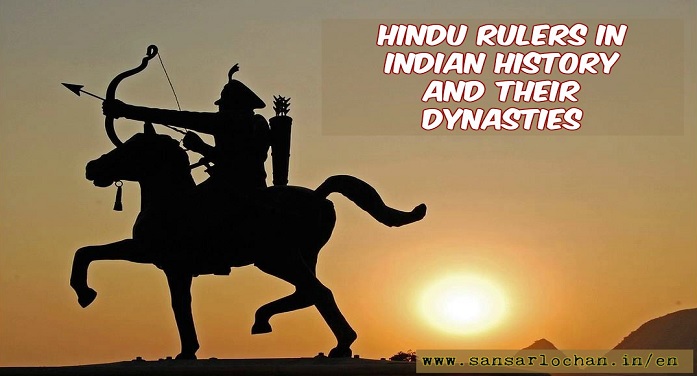The Pre-Mauryan Age
In 600 B.C. India was divided into a number of independent monarchies and republics. Kosala with its capital at Saraswati, Magadha with Rajagriha as its capital at Saraswati, Magadha with Rajagriha as its capital and Avanti with Ujjain as the seat of Government were important kingdoms. Besides these, there were a large number of smaller kingdoms and autonomous States, some enjoying complete independence and others more or less modified freedom.
Mauryan Dynasty (321 B.C. – 184 B.C.)
Chandra Gupta Maurya, 321-298 B.C.
He was the founder of the first historical Empire in India. He consolidated this huge Empire and perfected the machinery of Government. His Empire included Afghanistan, the Punjab, the United Provinces, Magadha (Bihar), the peninsula of Kathiawar and probably Bengal.
Ashoka the Great, 273-232 B.C.
He was the son of Bindusara. He conquered Kalinga in 261 B.C., his first and the last conquest. Ashoka’s work lay entirely in the sphere of religion and morals. He was the first teacher of universal humanity who spiritualized the ideas of Dig-Vijay by arms. Ashoka was the greatest king of his dynasty, one of the greatest kings in the world history and the greatest Buddhist Emperor. He sent monks to preach Buddhism outside India.
Kushan Dynasty
Kanishka, 120-162 A.D.
He was a great Empire builder. He conquered Kashmir, Kashgar, Khotan, Yarkand and made Peshawar his capital. Like Asoka, he was a great patron of Buddhism. But the Buddhism of his time was of the new type called Mahayana or Great Vehicle. His fame rests on his conquests of region of Central Asia and Indianization of Khotan areas; Gandhara School of Art was patronised by him.
Gupta Dynasty, (300-600 A.D.)
With the rise of Gupta Dynasty, the history of India entered upon a new era. India became a strong National Empire. The Guptas freed the country from foreign domination and restored the ancient Aryan supremacy – political, cultural and intellectual. It is known as the golden age of Hindu India.
Samudra Gupta, 330-375 A.D.
He was the son and successor of Chandra Gupta I. On account of his great conquests he is known as the Indian Napoleon. He received homage and tribute even from the Deccan rulers. Many foreign kings entered into diplomatic relations with him. He was a man of versatile genius – a great warrior, an accomplished ruler, a musician, poet and scholar.
Chandra Gupta II (Vikramaditya- The Sun of Power), 375-413 A.D.
He succeeded his father Samudra Gupta in 375 A.D. He was a renowned warrior and an accomplished prince. Chandra Gupta II drove away the foreigners form India. The Chinese traveler Fehien visited India in his time. Fabien says the country was rich and the people led a highly moral and honest life.
Vardhana Dynasty, 560-647 A.D.
Harsha Vardhana, 606-647 A.D.
He was the younger son of Prabhakar Vardhana, the Raja of Thanesar. On the tragic murder of his elder brother, Harsha occupied the throne. He made great conquests. Harsha devoted himself to the task of peace and promotion of the moral and material interests of people. Harsha Vardhana was known for his scholarship, philanthropy and toleration. Hiuen Tsang or Yuan Chwang, a Chinese pilgrim, visited India during his reign.
Maratha Dynasty (1649-1748 A.D.)
Chhatrapati Shivaji Maharaj, 1627-1680
He was the son of Shahaji Bhonsale, a Maratha chieftain in the service of the Ahmadnagar State. He was a born leader of men, a great General, an able administrator. Chhatrapati Shivaji Maharaj created a Hindu State in defiance of the Mughal Power, and unified the Maratha nation.

Peshwa Dynasty (1708-1818 A.D.)
Balaji Vishwanath, 1714-1720
He was the first Peshwa to become the de facto ruler. He was instrumental in the release of Sahu from the Mughal imprisonment and securing for him the throne of Satara. Balaji restored order in the Maratha kingdom and extended the Maratha influence. Balaji made the Maratha co-sharers of the Mughal revenue, and later the partners of the sovereignty as well. The whole of South India practically passed under the Maratha control.
Baji Rao I, 1720-1740
He was the son of Balaji Vishwanath, and the second Peshwa. Baji Rao expounded the ideal of Hindu-Pad-Padshahi, and secured the help of the Hindus and the Rajput rulers to gain that end. He intended to strike at the root of the Mughal Empire and curb it by one stroke. Baji Rao was a rare military genius, possessed a statesmanlike vision and a penetrating intellect. The Maratha influence, during his time, spread into Delhi, the Mughal capital.
Balaji Baji Rao, 1740-1761
He was the third Peshwa and succeeded to the throne on the death of his father Baji Rao. The Maratha power was at its zenith during his time. Unfortunately, he deviated from the idea of his father and denationalised the state and the army. There was indiscriminate loot and plunder of the people. The Maratha state became a parasitical growth, heading towards disaster which overtook it in the Battle of Panipat in 1761.
Madho Rao, 1761-1779
A very capable administrator and financier. He was a millitary genius. He early death is regarded as the cause of downfall of Marathas.

8 Comments on “List of Hindu Rulers in Indian History and their Important Dynasties”
Please tell me why vikramaditya is not in this link
There are many more who they forgot to mention
शिवाजी नाही, छत्रपती शिवाजी महाराज. कृपया हे ठिक करा.
Done!
chatrapati shivaji maharaj
He was the son of Shahji Bhonsla
Not a shahji bhonsla change the name–Shahaji Bhosale – [ ch. shivaji maharaj father ]
Corrected! Thanks
Where the heck is Vijayanagar Empire?? Chola Empire?? Please update your knowladge
Aap ki itihas ko chupane wali guide line bhi aap hi ki tarah kamjor hai thoda zor daalo apne dimag pe ya kisi janane wale se pu6ne baad yanha edit kar lete.